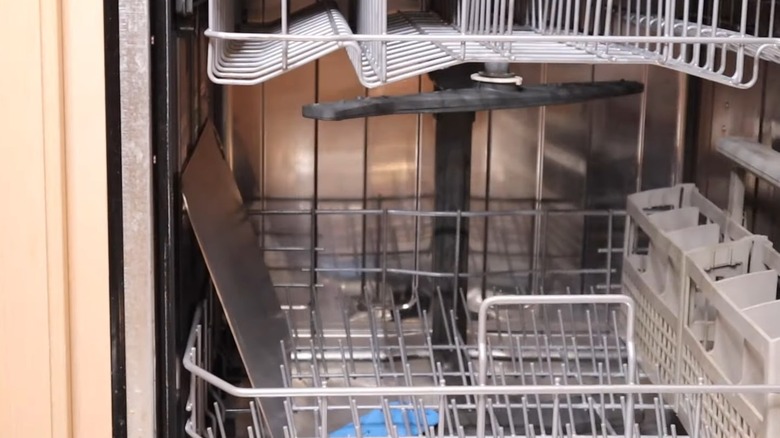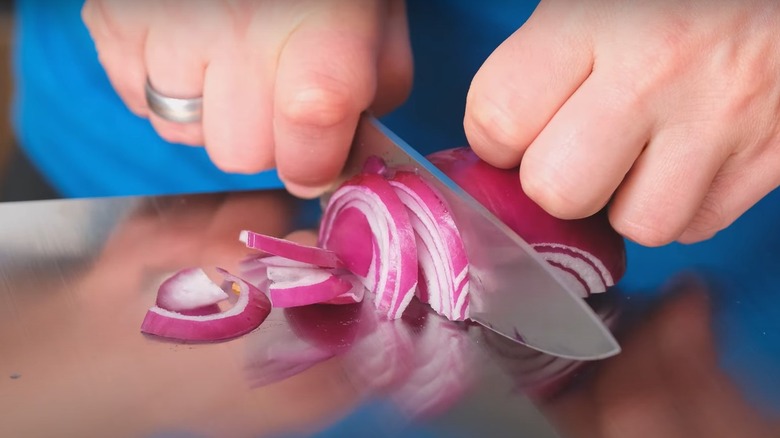Are Titanium Cutting Boards Truly Worth Buying? Here's What We Know
We may receive a commission on purchases made from links.
If you're starting to see signs that it's time to replace the cutting boards in your kitchen, you might be considering an upgrade altogether. Cutting boards made with titanium are relatively novel compared to glass, plastic, and wood-based versions you might be more familiar with. However, as a cutting board material, titanium has gained a reputation for being durable, hygienic, and non-toxic. Aside from such benefits, there are also some drawbacks to titanium cutting boards, such as their high cost. If you have extra money to spend on a higher-quality cutting board, though, you might find that the safety and durability of a titanium cutting board are worthwhile for your kitchen needs.
Titanium is a type of metal that's coveted for its strength and durability, while also being able to resist corrosion when exposed to water and other elements. It's commonly used in various industries, such as medical settings and marine work, but the metal itself is also manufactured into a variety of personal accessories and home goods. Before you invest in a titanium cutting board, it's important to weigh the benefits versus the downsides so you can determine whether this food prep item is truly worth the higher price tag.
Titanium cutting boards are durable, safe, and easy to clean
Every type of cutting board material has its list of pros and cons, and the same is true of titanium cutting boards. Some people prefer preparing food with titanium cutting boards because this non-porous material doesn't absorb odors like a wood or plastic cutting board might, and it's considered both scratch and stain-resistant. Despite appearances, titanium is also said to be knife-friendly, so you won't have to worry about your knives getting dull over time. Small surface scratches could possibly develop over time, though.
Titanium cutting boards are also lightweight compared with stainless steel cutting boards, which can make it easier to move around and clean. While you can put the cutting board in a dishwasher, titanium is easy to clean by hand, too. All you need to do is wipe the board down with a wet, soapy cloth and rinse after every use.
For comparison, a wood cutting board must always be washed by hand, and you should never put wooden utensils or cutting boards in the dishwasher. Wood boards also need oiling on a regular basis to maintain their lifespan. Plastic boards are also at risk of getting damaged in the dishwasher, and should be washed by hand. If you believe it's time to ditch plastic cutting boards due to the risk of microplastic exposure, you can rest knowing that the durability of titanium helps to ensure the material won't ever leech into your foods.
Like all cutting boards, titanium boards have drawbacks
Perhaps the biggest downside of getting a titanium cutting board is the expense. Titanium on its own is already a pricier metal, but the intricate manufacturing process is another aspect that contributes to the cost. Despite their higher price tags, keep in mind that you shouldn't have to replace titanium cutting boards as often compared with inexpensive plastic boards.
Another possible downside is the increased noise during food prep, as you'll essentially be using metal against metal. Also, you might find the board slippery when you're trying to cut up food. This can certainly be dangerous, and you might want to mitigate this problem by placing a non-slip item underneath the board, such as a large silicone potholder.
If you do decide to invest in a titanium cutting board, make sure that the manufacturer indicates that the product is made with 100% titanium, such as the Zaucet Titanium Cutting Board. Otherwise, a cutting board made with a titanium blend might not offer the same benefits.


